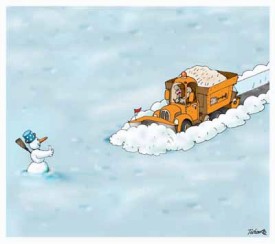Kosovo: North Mitrovica and “Returns”
Spring is approaching in the Balkans which means that folks will soon be out to plant crops and - in north Mitrovica - reconstruct houses. During the initial flurry of attention a few weeks ago on the EU strategy for the north, the Kosovo government promised some millions of Euros for supporting the "integration" of the north.
(Gerard Gallucci, Outside The Walls) Wednesday, February 24, 2010
What they meant was money to "rebuild" Kosovo Albanian houses in the sensitive areas of north Mitrovica and especially Brdjani - the scene of clashes last year - and Bosniak Mahala. The Albanians clearly wish to increase their hold on the north in expectation perhaps of facing some sort of partition. They - and their international supporters - seek to put this in the light of "returns." Who can argue with the right of people to return to their homes? But returns should either be in agreement with all local communities or part of a global approach to provide secure and sustainable returns everywhere and for all groups. There is no local agreement for returns to north Mitrovica and the south of Kosovo remains hostile to any possible Serb returns. (Many of the Serbs now living in the north - in some places where Albanians used to live - were themselves expelled from the south.) The attempt to clothe ethnic re-engineering as simply "returns" is disingenuous and dangerous.
To put this in context, while Serbs living in south Mitrovica were cleansed since 1999, many Albanians remained north of the Ibar during the events of that year and some - such as in Suvi Do - were able to return afterwards. No Serbs still live in Mitrovica south of the Ibar. A few thousand Albanians live in Mitrovica north of the River. (North Mitrovica is actually a bare sliver of the total municipality. It is the finger sticking north of the Ibar in the center of the city plus a wedge extending west on the north side of that river.) A small isolated pocket of Albanians remained in Kodra e Minatoreve (in the upper city, near the main Moslem cemetery of the city) right through the last decade. (The cemetery itself was never desecrated as was the Serb cemetery in the southern part.) Suvi Do (west of the downtown) is majority Albanian with a small Serb community in its middle. The high ground above Suvi Do - called Brdjani/Kroi Vitaku - was depopulated and served as a buffer between the Albanian villages - below and to the west on the north side of the Ibar - and the Serbian majority center immediately to the east. Bosniak Mahala - immediately east of the Main Bridge along the northern shore of the Ibar - is truly mixed. Serbs, Albanians, Turks, Bosniaks and others live intermingled to a surprising degree and the district serves as a common market area where everyone does business. Albanians also live in the area along the River and just west of the Main Bridge, mostly in the three apartment buildings known as the Three Towers. (Serbs live there too.)
So, north Mitrovica is already the most ethnically mixed urban area in Kosovo. But the mixture is in delicate balance. Any effort to change the equation substantially threatens to destabilize it. Both sides use construction to anchor or expand their areas. The UN office in north Mitrovica has tried to keep this struggle for ground within safe limits. In the days when it could call on UN police, sometimes it used them to draw lines. But mostly, the UN used dialogue to defuse conflicts and when necessary, simply did not allow construction in areas raising real security concerns. Neither side liked this but the Albanians were most critical as they saw it blocking their efforts to expand territory. Since the UN now has to rely on EULEX police - and with the UN granting the "rule of law" lead to the EU - the ability of the local UN office to restrain problematic construction has been greatly compromised. And last year, the EULEX police - aided by NATO - took the side of the Albanians in one of the most sensitive areas, Brdjani.
This is why the coming of the 2010 construction season is potentially dangerous. The Albanians will renew their pressure for "returns." On the past record - and consistent with its northern strategy - the EU is unlikely to restrain them and may again instead use force to support the Albanians. The UN is weakened and may itself be pushed into granting permission for provocative construction. It may even seek to regain a role in the north by prematurely pressing the Serbs to agree to reconstruction. At this point in the struggle over status, no attempted return to the north would be status neutral. The UN should not allow itself to be used to provide cover for Albanian/EU efforts to unsettle the ethnic balance in the north that has held so far. Forcing the Serbs to "agree" to reconstruction with which they really don't feel comfortable would simply create new spots for conflict. The north Mitrovica Serbs do not see reconstruction as a neutral matter but as an assault on their community. Even if Belgrade might be quiescent on this - the Quint is clearly increasing the diplomatic pressure on Serbia to be more agreeable on Kosovo - the local Serbs are unlikely to simply go along.
It all, it may be much more effective for the EU and the Kosovo government to work harder on Serb returns in the south. This would give them the moral standing they now lack to encourage returns in the north as well. And for the UN? It should indeed continue dialogue with the locals and Belgrade. Much remains to be done on implementing the six points - and especially reopening the courts - in the status-neutral manner that the EU has shown itself incapable of doing.
http://outsidewalls.blogspot.com/2010/02/kosovo-north-mitrovica-and-returns.html






